How new engines are driving down carbon emissions
29 September 2021
A look at how new engines can help construction businesses lower their carbon footprint
With the global drive towards net-zero carbon emissions now a daily topic of conversation, many construction industry contractors view investing in new engine technology as the easiest and quickest way – although not the cheapest – to lower their carbon footprint.
For contractors looking to buy new construction equipment - or to upgrade their existing fleets - new advancements and improvements in both diesel and petrol engines, can allow them to transition to low carbon equipment in a way that best supports their operations.
However, these new technological advancements also mean that deciding which engine to buy is now more involved than ever.
In addition to engine power output, maintenance costs and the initial expenditure, construction equipment buyers are now giving greater consideration to engine fuel types, efficiency, and aftertreatment systems.
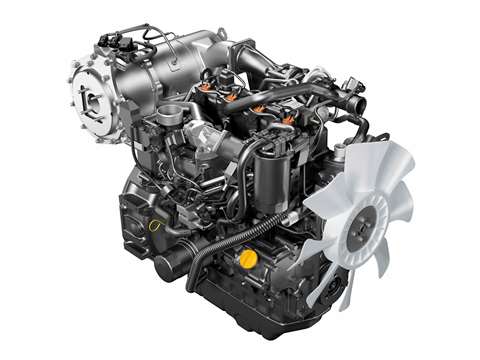 Yanmar 4TN86CHT Vertical Water-cooled Diesel Engine.
Yanmar 4TN86CHT Vertical Water-cooled Diesel Engine.
The good news, however, is that the European equipment market is leading the way when it comes to the range of low emission engines available.
Stage V diesel engines
For example, Yanmar Europe’s new 4TN86CHT diesel engine offers lower fuel consumption while also providing 55.4kW of power – 14% more than engines with the same 2.1 litre displacement in the company’s TNV engine range.
Described as “clean”, the 4-cylinder water-cooled engine meets both Stage V and Tier 4 emissions regulations and is fitted with a diesel particulate filter system for capturing soot from the engine’s exhaust fumes.
In addition to being more environmentally friendly, Yanmar says this helps keep the engine working at “high altitudes and at low temperatures, and under all work conditions, from light to heavy loads”.
The compact size of the 4TN86CHT engine, which entered mass production in April of 2021, means the output of the exhaust gas aftertreatment system has been increased and that contractors can use the model with their existing machinery.
How efficient engines reduce construction equipment emissions
Similarly, the new range of Stage V compliant engines from JCB Power Systems are designed for off-highway applications in both mobile and stationary construction equipment and generators.
The 448 engines are available in four power nodes from 81 to 129kW and have peak torque outputs ranging from 516 to 690Nm.
Higher powered than the company’s previously launched 430 engine in the under 56kW class, the new 448 models have been designed to offer maximum efficiency and lower fuel consumption – and therefore CO2 emissions.
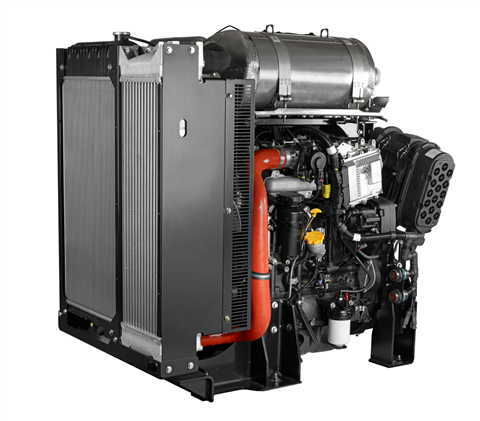 JCB’s 448 engines are available in four power nodes from 81 to 129kW and have peak torque outputs ranging from 516 to 690Nm.
JCB’s 448 engines are available in four power nodes from 81 to 129kW and have peak torque outputs ranging from 516 to 690Nm.
In addition to matching the performance of the 430, JCB’s 448 engines also incorporate a flexible engine mounted aftertreatment system, which reduces the amount of nitrogen oxide gas (NOx) emissions.
“Driven by legislation, the market for innovative and customer focused solutions is constantly evolving and with the introduction of these latest additions to the JCB Power Systems range, we and our customers will remain at the forefront of developments,” says Daniel Jackson, JCB Power Systems’ OEM engine sales and applications manager.
The 448 units have been compactly designed with common customer connection points, which enables contractors to have the models easily installed in their construction equipment.
Diesel engines for compact construction equipment
For those interested in smaller engines, Kubota Business Unit Engine Europe (BUEE) has recently developed the D902-K electronic controlled diesel engine, which offers both improved performance and 5% lower fuel consumption, when compared to its mechanically controlled D902 model.
Scheduled to enter mass production in 2022, the new Kubota 3-cyinder D902-K has a power rating of 18.5kW at 3600 rpm and is part of the manufacturer’s Super Mini engine range.
It features a new TVCR combustion chamber with a new common rail system, that allows the liquid-cooled 0.9lt diesel engine to be used as a replacement for conventional mechanically controlled models, says Kubota.
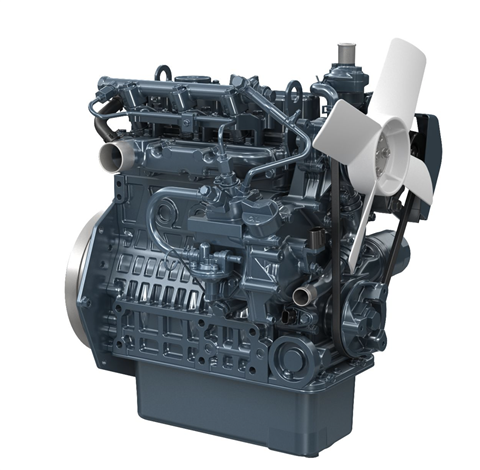 Kubota’s D902-K electronic controlled diesel engine offers 5% lower fuel consumption than its mechanically controlled D902 model.
Kubota’s D902-K electronic controlled diesel engine offers 5% lower fuel consumption than its mechanically controlled D902 model.
“When you talk about common rail fuel injection systems, it is normally regarded as a medium- to large-size engine technology, and it is pretty much the industry standard now,” says Daniel Grant, manager, marketing intelligence for the Kubota BUEE.
“Trying to condense that into what is a very, very small engine architecture takes a considerable amount of redesign, particularly around the cylinder head.
“So the combustion and fuel system have been bespoke designed to suit that engine architecture without compromising in terms of durability, reliability and performance.”
It uses CAN (Controller Area Network) communications protocols to collect engine data and to adjust operating parameters in real-time.
With no aftertreatment system needed, the D902-K is the same size as its mechanical sister model, the D902.
Grant says, this means the engine is suitable for hybrid applications and as a virtual drop-in for compact wheeled loaders, mini excavators and aerial work platforms and access equipment.
Petrol engines
On the petrol side of the construction equipment market, new Vanguard V-Twin 29.9kW engine from Briggs & Stratton offers equipment owners and users fuel savings of up to 25%.
The defining feature of the Stage V engine is that is uses a combination of Electronic Fuel Injection (EFI) and Electronic Throttle Control (ETC) technologies.
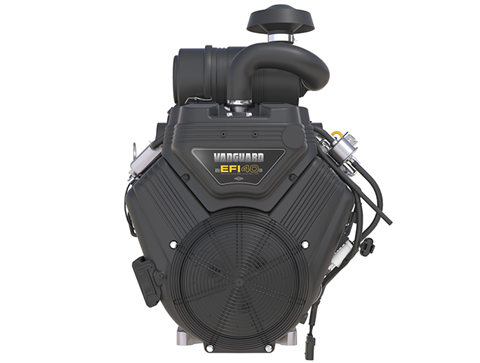 The new Vanguard V-Twin 29.9kW engine from Briggs & Stratton.
The new Vanguard V-Twin 29.9kW engine from Briggs & Stratton.
Briggs & Stratton says its Vanguard ETC maintains the engine’s power output by instantly adjusting to the machine’s activities, while also enabling it to be used with “remote or unmanned equipment”.
Paul Bramhall, director for marketing EMEA of engines & power at Briggs & Stratton, says, “ETC technology provides a smoother and more consistent performance as more load is applied.
“And by combining EFI and ETC, we deliver an efficient alternative to diesel for a wide variety of applications.”
The Vanguard V-Twin 29.9kW can be used with both utility vehicles and smaller pieces of construction equipment, and does not need an aftertreatment system or diesel particulate filters.
Said to be quieter than similar diesel models, contractors can use equipment fitted with the engines in urban areas, where noise and pollution regulations are likely to be in place.
While diesel and petrol engines are still the beating heart of the construction equipment industry, recent years have seen electric powered machinery garner more and more attention.
Electric powered and hybrid equipment
A case in point is the new JCB 525-60E Loadall electric telehandler, which has seen the conventional combustion engine replaced with two 22 kW electric motors, a 24kWh lithium-ion battery that powers a 96V electric system, a conventional 12V battery for ancillary functions and a motor controller.
Similarly, Wacker Neuson’s electric powered WL20-e has also drawn attention for its zero-emissions status.
The 2.3 tonnes wheeled loader is powered by an AGM (Absorbent Glass Mat) battery and has two electric engines, one for the drive system and one for the hydraulics. The model is said to save around 90% of CO₂ emissions over its entire service life, when compared to similar machines with combustion engines.
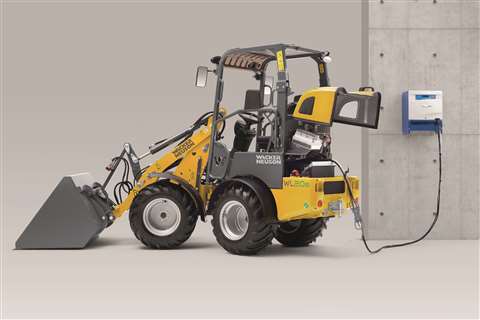 The Wacker Neuson WL20e wheeled loader weighs 2.3 tonnes and is powered by an Absorbent Glass Mat battery.
The Wacker Neuson WL20e wheeled loader weighs 2.3 tonnes and is powered by an Absorbent Glass Mat battery.
Larger construction machines too, are also being developed to incorporate electric power.
Take the e-Power range of hybrid Lokotrack crushers and screeners from Metso Outotec for example. The diesel-electric equipment line, which comprises 15 crushers and six screens, are equipped with drivelines that incorporate both a crusher motor and a generator, alongside a diesel engine.
While electric and hybrid engines are now firmly established as viable choices for contractors, particularly for those choosing to rent equipment, the age of hydrogen power is now upon us.
Hydrogen engines
The new TCG 7.8 H2 from Deutz, which is currently undergoing pilot testing prior to entering full production in 2024.
The company’s first hydrogen engine, Deutz says the drive “meets all of the eligibility criteria set by the EU for zero CO2 emission engines” and has already passed initial tests “with flying colours”.
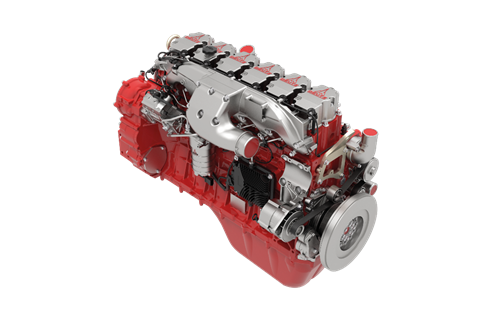 Testing of the new hydrogen powered TCG 7.8 H2 from Deutz will begin in 2022.
Testing of the new hydrogen powered TCG 7.8 H2 from Deutz will begin in 2022.
Dr Markus Müller, chief technology officer at Deutz, says, “The six-cylinder TCG 7.8 H2 is based on an existing engine design.
“Generating a power output of 200kW it runs carbon-neutral and very quietly. In principle, the engine is suitable for all current Deutz applications, but due to the available infrastructure it is likely to be used first in stationary equipment, generators, and rail transport.”
Deutz says it will initially examine the model’s performance in stationary equipment for power generation via a partnership with a regional utility company.
“The pilot is scheduled to commence at the beginning of 2022 with the aim of demonstrating the engine’s suitability for everyday use”, says Deutz.
While it may be some time before contractors are able to embrace hydrogen engines as a collective, the continued development of low carbon technologies is certain to transform more than just engine design.
The successful application of clean energy products, systems, technologies and methodologies will reach into every aspect of the construction industry – from equipment to building management to infrastructure design – much sooner than it will for other sectors.
Therefore it’s clear that any time construction industry contractors can spend getting familiar with these new fuel developments, would not be a waste.
For more on how hydrogen is helping the global construction industry towards a greener future, click here.

How telematics can improve engine performanceEngine manufacturer Cummins has integrated its digital engine applications Connected engine solutions with the ability to work alongside telematics services from companies including Topcon, Trimble, Saucon and TelliQ. Cummins Connected Diagnostics, which continuously monitors engines and diagnoses system faults via a wireless connection, and its Connected Software Updates – an over-the air engine control system that provides module software updates to maximise asset performance - can now work in sync with equipment that features telematics systems from the above providers. According to Cummins, many construction equipment manufacturers are “developing their own telematics capability”. With its new digital applications now integrated with their systems via the machine network, equipment owners can have “all the machine information, including the engine, in one place via a single interface”. Jeremy Harsin, off-highway business director at Cummins, says, “Telematics has emerged as a key enabler to improve operational efficiency of machines at construction sites, ports, distribution centers and farms. “With the majority of these environments having mixed fleets, managers need a solution that is compatible across their machinery.” |
STAY CONNECTED



Receive the information you need when you need it through our world-leading magazines, newsletters and daily briefings.
CONNECT WITH THE TEAM








